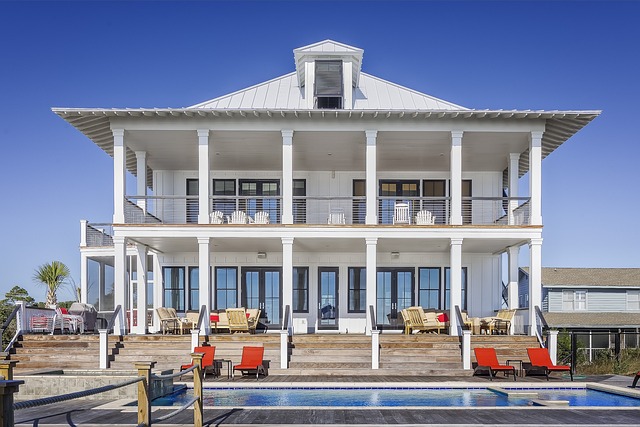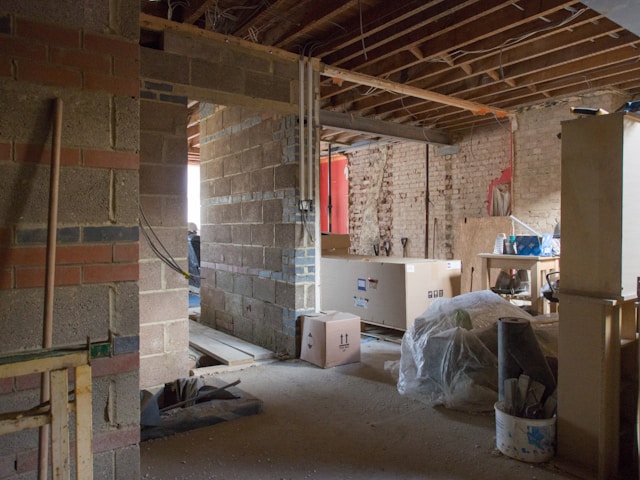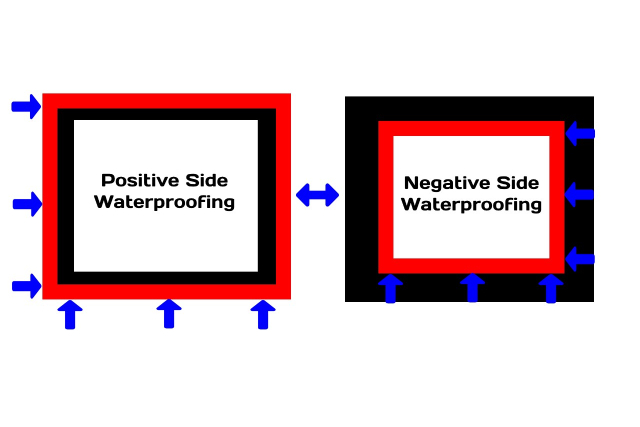Building a solid foundation starts with a waterproof one. But how do you achieve that waterproofing? There are two main approaches: negative side waterproofing and positive side waterproofing.
Let’s delve into the world of below-grade water defence and explore the differences between these two methods.
What Is Negative Waterproofing?

Negative side waterproofing, also known as internal waterproofing, tackles water intrusion from the inside of a structure. This method is typically used for existing structures where accessing the exterior for waterproofing is difficult or impossible.
Imagine a basement in a high-rise building—applying external waterproofing wouldn’t be feasible due to surrounding structures. In such cases, negative-side waterproofing becomes the solution.
Does Negative Side Waterproofing Work?
Yes, negative-side waterproofing can be effective in preventing water leaks. However, it’s essential to understand its limitations. While it protects the interior from water ingress, it allows moisture to enter the structure itself.
This trapped moisture can damage the building materials over time. Additionally, adverse side waterproofing requires meticulous installation to ensure a complete seal and prevent future issues.
What Is the Difference Between Negative and Positive Waterproofing?
The key difference between positive and negative lies in the application location and how they address water intrusion. Here’s a deeper dive into their contrasting approaches:
Location:
Positive side waterproofing
This method applies the waterproofing membrane on the exterior of the structure, directly against the soil. Imagine a building’s foundation – the membrane would be installed on the outside walls, creating a barrier between the soil and the building materials.
Negative side waterproofing
As the name suggests, this method tackles water from the interior of the structure. The waterproofing membrane is applied on the inside walls of the basement or foundation, essentially creating a secondary layer of defence.
Waterproofing Strategy
Positive side waterproofing
This method acts as a first line of defence. By intercepting water before it reaches the building components, it prevents moisture from entering the foundation walls and concrete in the first place. This approach offers the most comprehensive protection for the structure itself.
Negative side waterproofing
This method addresses water that has already managed to penetrate the building envelope. It acts as a secondary barrier, preventing water from migrating further into the interior space and causing damage to finishes, furnishings, and potentially even structural components.
Impact on Building Materials
Positive side waterproofing
Since it prevents water from entering the building materials altogether, positive-side waterproofing helps extend the foundation’s lifespan. It minimises the risk of water-related issues like cracking mould growth and efflorescence (the white, powdery residue that can appear on basement walls).
Negative side waterproofing
While it protects the interior from water damage, it allows some moisture to become trapped within the structure. This trapped moisture can potentially lead to material degradation over time, mainly if not addressed with proper ventilation or a drainage system.
Durability and Maintenance
Positive side waterproofing
External membranes used in positive side waterproofing are generally more robust and can withstand harsher conditions like sun exposure, rain, and freezing temperatures. However, repairs to a damaged external membrane can be complex and might require excavation.
Negative side waterproofing
Since they are applied indoors, negative pressure waterproofing materials may be more susceptible to damage from everyday wear and tear. Additionally, monitoring for leaks or issues can be trickier as they might need to be more readily apparent.
Choosing the Right Method
The decision between negative and positive side waterproofing depends on your specific situation. Here’s a quick breakdown:
New construction
Positive side waterproofing is generally the recommended approach for its superior protection and durability.
Existing structures
Negative waterproofing becomes the option when accessing the exterior is not possible.
For optimal waterproofing, consulting with a professional is crucial. They can assess your specific needs, recommend the most suitable method, and ensure a successful waterproofing project to keep your basement dry and your building healthy.
Additional Considerations for Negative Pressure Waterproofing
While negative waterproofing offers a solution for existing structures, there are some additional factors to consider:
Material Selection
Due to the trapped moisture, a suitable waterproofing material for harmful applications must be chosen. Breathable membranes allow some moisture vapour to escape, reducing the risk of internal damage.
Drainage System
A properly designed drainage system is vital, even with a good waterproofing membrane. This system collects any water that seeps through the structure and channels it away from the foundation, minimising its impact.
Maintenance
Negative side waterproofing requires regular monitoring for signs of leaks or damage. Addressing any issues promptly helps maintain the integrity of the waterproofing system.
Advantages of Negative Waterproofing

While positive side waterproofing might be the ideal scenario for new construction, negative offers some distinct advantages:
Accessibility
In situations where accessing the exterior is impossible due to surrounding structures or limited space, negative side waterproofing provides a viable alternative.
Cost-Effectiveness
Retrofitting existing structures with negative waterproofing services can be less expensive compared to extensive excavation required for external applications.
Disruption Minimised
Applying negative-side waterproofing from the inside less disrupts the interior space than external methods, making it a good option for occupied buildings.
Don't Let Leaks Leave You High and Dry: Take Action Today
Understanding the differences between positive and negative waterproofing in Gold Coast & Brisbane is a crucial first step in protecting your basement or foundation from water damage. But knowledge is only half the battle.
A qualified provider of waterproofing service can assess your specific situation, identify any existing water issues, and recommend the most suitable waterproofing method for your needs.
Once you understand the recommended approach, get quotes from reputable waterproofing companies like S&S Remedial to ensure you’re getting the best value for your investment.
A properly designed and installed waterproofing system can save you money in the long run by preventing costly repairs from water damage.
Don’t wait until leaks become a major problem – take action today to safeguard your basement and ensure a dry, healthy environment for your property.


